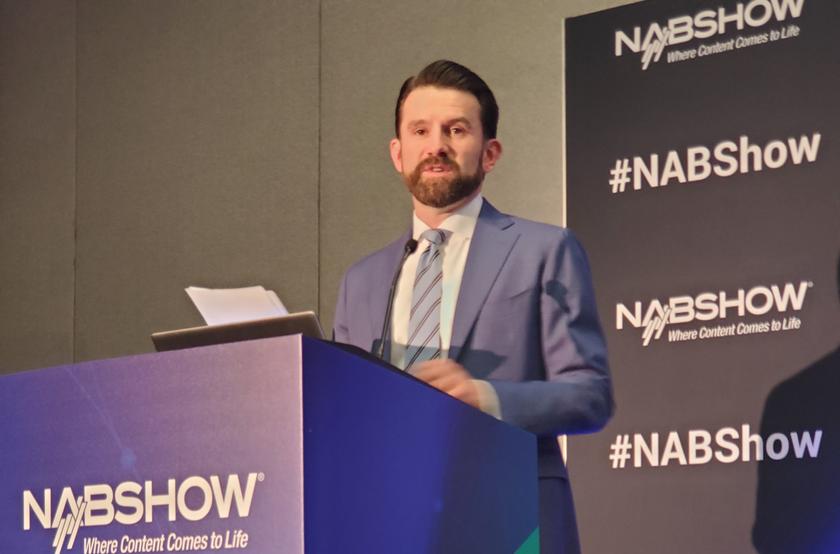NAB Show: All the World’s a Stage
While the 2019 NAB Show was no world stage, there were indeed the industry men and women from around the globe in attendance. In addition, they were actively engaged in a diverse range of debates centered around a multiplicity of contemporary industry movements. Arguably, there were simply too many options in play—largely driven by multiple disparate technologies—that were consuming all of the players within content creation teams, broadcasters, technologists, system integrators and business management.

A looming backdrop were recent seismic convulsions among the media giants as they continued to pivot in their grappling with the still-growing tech giants—in both content creation and content distribution. Within this industry maelstrom, related technologies (and associated debates) were being unleashed on many fronts—4K UHD, HDR, cloud production, IP production, 5G, esports, AR/VR, and the hot new topic of AI and ML supporting content creation.
CONTENT CREATION, THE STUFF DREAMS ARE MADE OF
In content creation—1080P fortified with HDR and WCG—emerged in the mainstream of at least near-term live productions in the United States, propelled by the ongoing caution among broadcasters and cable operators about any plunge into 4K UHD distribution services. That said, 4K UHD was indisputably being more positively spoken about as an inevitable transition in the mid to long-term. The overwhelming dominance of 4K products at this show, and their steadily declining price points, added an air of inevitability to the acceptance that at least content masters should be in 4K, regardless of short to mid-term distribution strategies.
Over the past few years, the promise of 4K imagery on larger screens had increasingly spurred sports and concert producers to seek greater framing options in lenses—and this propelled the debut of second-generation 2/3-inch long zoom 4K UHD lenses having greater focal reach and a wider angle of view. Traditionally, the simultaneous extension of focal range at both extremes has eluded the optical manufacturers for decades—an inherent optical conflict conspiring to thwart this—but this NAB saw new long zoom field lenses that broke that barrier.
The early experiences of the first generation 4K UHD lenses also had led to industry exhortations on tightening specifications on 4K UHD sharpness and chromatic aberrations at picture extremes as well as significantly improving image stabilization. Here too, impressive improvements were demonstrated at NAB. Additionally, the solution to a longstanding nemesis of long zoom broadcast lenses—namely, “lens ramping” (the drop in light transmission through the lens when zooming reaches a critical focal length) which has vexed sports directors and camera operators for decades—was demonstrated at the show. This, in the form of the novel collaboration between Canon and Sony and termed ARIA (Automatic Restoration of Illumination Attenuation), should play well on the world stage of sports and concerts.
ALL THAT GLITTERS IS NOT GOLD: 8K UHD
Paradoxically, at CES and NAB, the high visibility of 8K UHD hung like a Sword of Damocles over the many TV transition scenarios being explored, sparking new debates among the industry’s engineers, production teams and business managers. 8K cameras were sprinkled throughout the show floor and 8K displays were ubiquitous. A newly formed U.S.-based 8K Association held an all-day seminar during NAB—with one notable presentation arguing that 8K is virtually unstoppable.
Technologically, there is little question that it is advancing rapidly, but sadly absent was any clear messaging on how the technical prowess of 8K imagery can ever be expressed in the living room; that is, the continuing avoidance of any discussion on requisite screen sizes. Seems indeed to be that all the men and women are mere players within this technological tsunami. Nevertheless, 8K imaging will surely do wonders for the future of large screen cinema and multiple other large screen venues such as museums, art galleries and digital signage.
THE GAME IS AFOOT: LARGE FORMAT IMAGING
Large format lenses and cameras have continued their brisk expansion in both product developments as well as their widening penetration of most genres of entertainment production. Full-frame 35mm digital cameras are now more firmly established for high-end television and theatrical motion picture production than they were a year ago—and they are flanked by fast-moving developments in associated zoom and prime lenses from multiple global optical manufacturers. Indeed, many commented that optics seemed to be the central theme of NAB. Meanwhile, a large image format (larger than the established 2/3-inch) has entered the television production arena—the 1.0- inch single sensor camcorder has moved to center stage with highly innovative new products being offered by most of the major manufacturers at NAB—and they are all 4K. The imaging advantages of this larger format are flanked by disparate high-performance recording codecs used in these new products and has sparked broad-ranging debate and comparative evaluations.

MUCH ADO ABOUT NOTHING: SMARTPHONE IMAGING IN BROADCAST TV
The upstart smartphone continued nudging its way onto the world stage of imaging in numerous manifestations. Smartphones bristling with 4K OLED displays, cinematic displays, multiple cameras within one device (to offer ultra wide to telephoto shooting options), were very visible. Discussions abounded on the possibilities of such devices for broadcast newsgathering—possibly furthering the winter of discontent for professional broadcast camera and lens manufacturers. Given the number of significant movies shot over the past year on smartphones that have gained unusual visibility, the specter of broadcast television adopting this maverick imaging medium cannot be ignored.
THOUGH IT’S MADNESS, THERE IS A METHOD: A WORLD BEYOND SDI
IP infrastructures dominate a great deal of contemporary industry discussion and activities. Confidence in the SMPTE 2110 standard has grown substantially, but is tempered by multiple hard lessons in implementation by those who have undertaken major IP projects over the past couple of years. This was a topic of much discussion throughout Las Vegas. This also encompasses the experiences of those who have built the first IP television mobile production trucks. But, the multiple exhibits, and the many presentations and panel discussions at NAB left little doubt that the broadcast television industry migration to IP infrastructures and workflows is now in full swing—it squarely preoccupies the many men and women on the world broadcast stage.
Infrastructure discussions have expanded among major industry players as many contemplate the deployment of software defined networks (SDN) for moving many production applications into the cloud. Successful multiple worldwide project implementations, contemplation of possible projects by many, and firm rejection by some of any consideration of broadcast television infrastructures in the cloud—were all fodder for this broadening industry discussion.
Notwithstanding this brave new world, the proliferation of 12G SDI on multiple products at the show appeared to have injected new life into the world of SDI.
IN A BETTER WORLD THAN THIS: ESPORTS
Esports has literally exploded over the past year. More players, more dedicated studios and rapidly escalating technological developments abound. The adaptation of existing venues like cinemas for esports is now being overtaken by purpose-built venues of extraordinary sophistication. Production studios, production control rooms, and large high-resolution displays are central to these installations and are creating a new A/V system integration business. Esports has surely morphed into a global stage where many men and women play.
BE-ALL AND END-ALL: DIRECT VIEW CINEMA
Over the past year, direct view digital cinema has leapt to the forefront of discussion within the global cinema communities—propelled by dazzling demonstrations by Sony, Samsung, and others (Sony’s 8K direct view Crystal LED cinema screen drew particularly large crowds). Last year, the Digital Cinema Initiatives published its draft “Direct View Display-D-Cinema Addendum” document reflecting the consensus of some in the international digital cinema industry that might ultimately lead to formal standardization. Following the first installations of such displays in disparate regions of the world stage, it seems however, that the industry has paused slightly—as if to absorb the success (or not) of these first installations.
ALL’S WELL THAT ENDS WELL: 5G
Meanwhile, 5G hovers over the global stage—and here the players become even more numerous with all of the technical, business and political considerations now under intense global debate. Perhaps the central theme of these discussions was just how real 5G is at this juncture, and how rapidly will it in fact advance over the next couple of years. But, the promise is surely huge.
Larry Thorpe is Senior Fellow, Imaging Technologies & Communications Group at Canon U.S.A.
Get the TV Tech Newsletter
The professional video industry's #1 source for news, trends and product and tech information. Sign up below.













